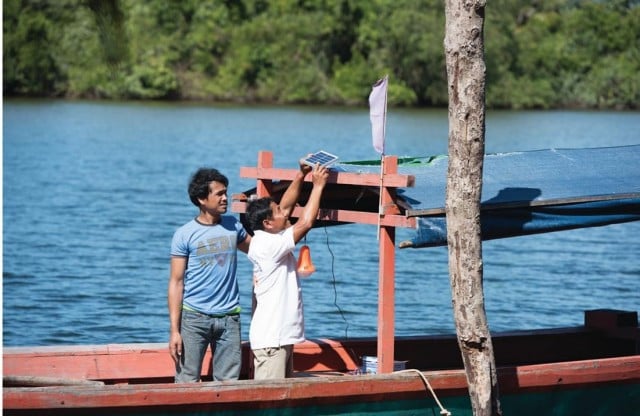Labor and Economic Reports for 2020 Outline Situations in Cambodia Dominated by COVID-19

- Phoung Vantha
- December 18, 2020 8:37 AM
suggesting measures while pointing out that uncertainty remains until the pandemic is over
PHNOM PENH--Economic and labor-situation reports on Cambodia and the region, which were released on Dec. 16, described issues prompted by the COVID-19 pandemic that will take time and government policies to address.
According to the World Bank’s press release on its “Restrained Recovery” report on Cambodia, “[t]he economy is projected to contract by 2 percent in 2020, but is expected to bounce back and grow by 4 percent in 2021.”
At this point, consumption is partly underpinned by unprecedented government intervention, while inflation remained subdued, the press release read.
However, Inguna Dobraja, World Bank country manager, said, [s]ignificant uncertainty remains to Cambodia’s growth outlook. The most important policy goal must be to urgently regain jobs lost and suspended due to the pandemic.
“Looking ahead, it is essential that domestic and foreign investment are encouraged to take advantage of recent bilateral and regional free trade agreements,” she said, such as the Cambodia-China Free Trade Agreement and the Regional Comprehensive Economic Partnership. “This would be possible through prompt introduction of a competitive investment law and incentive schemes, together with moves to improve the ease of doing business.”
But what will also help the country quickly recover from the pandemic, the World Bank report said, “[is] boosting pro-poor and growth-enhancing public investment including cash-for-work projects, while promoting labor-intensive sectors to generate jobs.”
Regarding the loss of jobs and workers’ situation triggered by the pandemic in the region, the situation described by the United Nations’ International Labour Organization in a report released on Dec. 16 is a bleak one.
“COVID-19 has inflicted a hammer-blow on the region’s labour markets, one that few governments in the region stood ready to handle,” said Chihoko Asada Miyakawa, ILO regional director for Asia and the Pacific, according to an ILO press release. “Low levels of social security coverage and limited institutional capacity in many countries have made it difficult to help enterprises and workers back on their feet, a situation compounded when large numbers remain in the informal economy.
“These pre-crisis weaknesses have left far too many exposed to the pain of economic insecurity when the pandemic hit and inflicted its toll on working hours and jobs,” she said.
Earlier this year, the Asian Development Bank’s preliminary estimates were that 390,000 to 570,000 jobs might be lost in Cambodia in 2020.
Workers most impacted by the pandemic
Among workers, women and young people have been the most affected with an employment loss three to 18 times higher than their share in total employment, the ILO press release read. “With increased unemployment, young workers are likely to find it difficult to compete for new jobs,” says Sara Elder, senior economist at the ILO Regional Office for Asia and the Pacific.
“When they do find work, it may well be a job that does not match to their aspirations,” she said. “Millions of women have also paid a high price and it could take years for those who have exited the labour force to return to full employment.”
This pandemic is the more a setback that Cambodia and four other countries were making progress to alleviate poverty in the country, the ILO states in its executive summary. “Working poverty…at least at the most extreme level (living on less than $1.90 a day) was declining before the COVID-19 pandemic…Five countries stood out for reducing the working-poverty rate by more than 3 percentage points during that three-year period: Afghanistan, Bangladesh, Cambodia, India and Lao People’s Democratic Republic.”
According to the Asian Development Bank’s “Employment and Poverty Impact Assessment: Cambodia” for 2020, “[p]reliminary estimates show that 130,000 to 205,000 additional workers could fall into extreme poverty and over 800,000 to 1.1 million near poor could fall into the moderately poor category.”
One reason why the Asia-Pacific region was so affected by the pandemic has been the large number of informal workers in the region, the executive summary read. “The share of workers in informal employment (including agriculture) was estimated at…75.2 per cent for South-East Asia and the Pacific…the majority of informal workers remain outside the limited systems of social protection and also health protection (despite some national efforts to extend assistance during the crisis period).”
One recommendation ILO makes is for countries to offer support to informal workers and businesses, the summary read, “not as a law and order issue or as an opportunity to earn government revenues but as investment towards development.”
Finally, migrant workers have been the hardest hit in the region, finding themselves with no job opportunities when they returned home due to the pandemic as they did in Cambodia, the summary read.
Faced with this health and economic crisis, the ILO summary said, Cambodia was among 10 nations in similar economic situations that took action. “Of the 36 economies in the Asia–Pacific region with comparable data, ten have dedicated COVID-19 response resources to supporting incomes and revenue…The ten—Afghanistan, Cambodia, Cook Islands, Kiribati, Marshall Islands, Palau, Samoa, Solomon Islands, Tonga and Tuvalu—are small developing economies, most with extremely limited fiscal space, which they thus have chosen to focus entirely to bolstering the incomes of people most in need.”
As to what is the best course of action for countries to promote a faster economic and labor market
recovery when the pandemic is over, it still is too early to tell, ILO said in its summary. “But there is something to be said for governments that are focusing on how to replace their crisis support measures with broader policy reforms that address the long-term stagnant growth trajectories that the Asian–Pacific economies faced before the pandemic.”
Attempts to contact Labor Ministry spokesman Heng Sour for comments prior to publication have remained unsuccessful.















